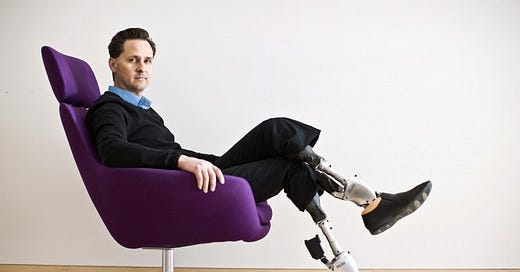Reframing as a Springboard to Breakthrough: the Case of Hugh Herr
"I'm not handicapped, the technology is."
Hugh Herr, Director of MIT Media Lab's Biomechatronics Research Group.
Over the last month, I’ve been examining how cultivating intention, purpose and solidarity can provide us with the means to rise. One benefit of being intentional is that it frees us to reframe how we approach our work, our careers, even our lives.
The power of reframing lies in its ability to tap into the powerful positive emotions associated with an idea we are comfortable with, while avoiding the negative emotions associated with an idea we are uncomfortable with. For example, if we reframe being ambitious as being eager to contribute, we can get more comfortable talking about our achievements.
This week I’d like to introduce you to a true master of reframing, the extraordinary Hugh Herr.
In 2016, I profiled Hugh Herr for Strategy + Business magazine (you can link to the article here). An MIT Media Lab computer scientist, mechanical engineer, biophysicist and inveterate mountain climber, Herr left a strong impression on me, as he has on almost anyone who has listened to his story. Not only is he brilliant, accomplished, innovative and extremely charismatic, he is also a double amputee, having lost both legs below the knee in a climbing accident.
That was nearly 40 years ago. And since then? Talk about making a contribution! Herr has done no less than create the foundational science that is eliminating the whole concept of disability as humanity has known it.
Herr’s innovations include an artificial knee that adapts to an individual’s walking gait and an ankle-foot exoskeleton for patients suffering from drop foot, a pathology caused by stroke, cerebral palsy and multiple sclerosis. He also fashioned feet that would suit various climbing situations, for example sculpting a blade that would enable him to secure a foothold on a ledge-- a functional improvement on an ordinary human foot.
Far from viewing the loss of his own legs as a disability, Herr considers it a kind of “fortunate wound” that imbued him with an overriding sense of purpose: it spurred him to immerse himself in robotics in a very personal quest to develop superior prosthetics. “I am not handicapped,” he says, “the technology is.“
Known outside scientific circles for his powerful TED talks, Herr strides about the stage on robotic-looking legs of his own design. His patented system uses a bionic foot and calf system known commercially as the BiOM. It is the only prosthetic with powered push-off, which means the calf function in walking is replicated, because an algorithm in the ankle measures every step. This push-off gives the wearer the sensation of actually moving his or her leg.
Herr’s reframing of loss as opportunity was done by sheer dint of will. Ranked at age 14 as one of the best amateur mountain climbers in the world, he lost his legs to frostbite 3 years later while climbing Mt. Washington, the tallest peak in the northeast with a friend. During an extended whiteout, they became lost in a wasteland known as The Great Gulf Herr and his friend survived for two nights and three days but when they were finally heliported to a local hospital, both boys would end up losing limbs.
Four decades later, Herr is still reframing adversity as a springboard for achieving breakthrough: he simply does not accept constraints or see limitations as intrinsic. “When it comes to the human capacity to adapt, I literally do not see boundaries. I am dependent on technology but technology itself is limitless.”
Not surprisingly, his work is influential among so-called “body hackers” –– the loosely organized grassroots activists who implant electronics (tracking devices, headphones, usb drives, bluetooth-enabled artificial ears) into their own bodies. It doesn’t bother Herr that body hackers’ motivation is less rehabilitative than aspirational and transgressive. Herr sees his own work as “extinguishing the conceptual and social divide between man and machine.” He adds that in doing so, he is less interested in making humans more machine-like than making machines more human. He is inspired by the desire to repair damaged bodies rather than building conscious machines or living forever. His contribution is as much to humanity, as to science.
The lesson of Hugh Herr’s experience is clear for anyone facing daunting challenges or even minor ones: reframing is a powerful technique which we can use to innovate, to rise after tragedy or setback, to overcome seemingly intractable difficulties with creative solutions that change the world. Maybe few of us have the unusual combination of brilliance and grit that are so abundant in Hugh Herr. But we can learn from his experience and be inspired by his example.




